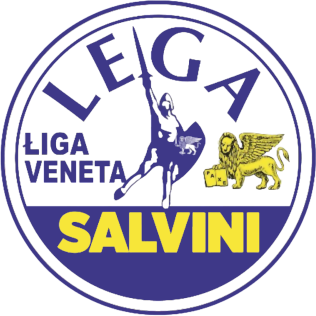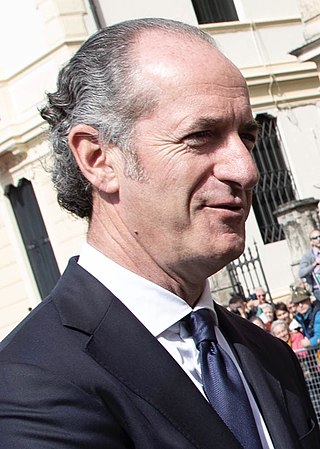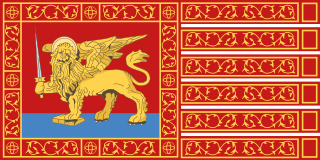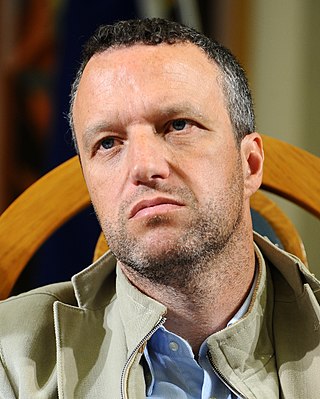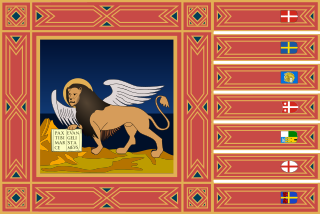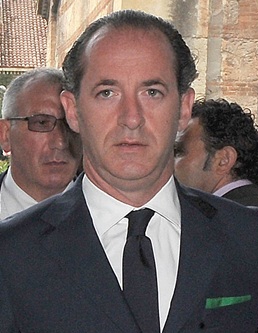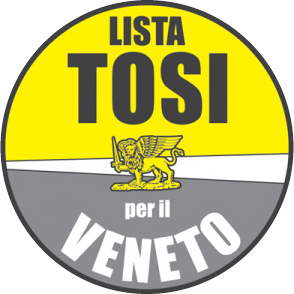Electoral history
The provincial breakdown of selected election results is shown in the tables below. Only parties above 5% are included.
- 1946 general election
The 1946 general election was the first after the return of democracy. Christian Democracy (DC) was by far the largest party (49.5%) and was especially strong in the provinces of Vicenza (61.1%), Padua (55.7%) and Treviso (53.5%). The Italian Socialist Party (PSI) came second (26.7%) and was stronger in the provinces of Rovigo (35.7%), Verona (33.3%) and Belluno (28.7%). The Italian Communist Party (PCI) was a distant third (13.6%), but came second in Rovigo (28.5%), where the parties of the left gained a large majority (56.5%). Rovigo, the southernmost province, was influenced by nearby "red" Emilia-Romagna.
Source: Regional Council of Veneto
- 1948 general election
The 1948 general election was a triumph for DC, which won a thumping 60.5% throughout Veneto. The party did better in its traditional strongholds, Vicenza (71.8%), Padua (65.4%) and Treviso (64.9%). The PSI and the PCI, united in the Popular Democratic Front (FDP), won a mere 23.9% of the vote. Apart from Rovigo, where the FDP gained 48.2%, many Socialist votes went to DC and the Italian Democratic Socialist Party (PSDI), an outfit formed by those Socialists who opposed the alliance with the Communists. The PSDI garnered 10.1% of the vote at the regional level and was stronger in Belluno (15.9%), Treviso (12.6%) and Verona (10.1%).
Source: Regional Council of Veneto
- 1953 general election
In the 1953 general election DC lost some ground, however gaining a convincing 53.4% of the vote (62.2% in Vicenza, 59.9% in Treviso and 59.6% in Padua). The PSI and the PCI ran separate lists, gaining 14.6 and 14.2% of the vote. Veneto was thus one of the few regions of Italy where the Socialists were stronger than the PCI, even without counting the PSDI (5.6%). The PSI got its best results in the provinces of Venice (21.6%), Rovigo (19.8%) and Verona (18.2%), but not in the traditional Socialist stronghold of Belluno, where it was passed by the PSDI (12.3 against 11.0%). The PCI was stronger in Rovigo (28.2%) and Venice (19.7%).
Source: Regional Council of Veneto
- 1970 regional election
Election results were quite stable for four decades. In the 1970 regional election, the first after the establishment of Veneto as a Region, DC was by far the largest party with 51.8%. As usual, its strongholds included the provinces of Vicenza (64.2%), Padua (56.3%) and Treviso (56.0%). Up to that time the PCI had passed the PSI as second largest party: in 1970 the former garnered 16.8%, the second 10.4% and the PSDI 7.6%. Rovigo was the most left-wing province (the sum of PCI and PSI was 42.3%), followed by Venice (39.2%), and Belluno the most Socialist one (the sum of PSDI and PSI was 27.9%), followed by Treviso (20.6%).
Source: Regional Council of Veneto
- 1990 regional election
Since 1980 DC experienced a steady decline in term of votes, largely due to the rise of Liga Veneta (LV) and other Venetist parties. In the 1990 regional election DC was still the largest party of Veneto (42.4%), but suffered the competition of the LV in its heartlands. Venetist parties were fairly strong in Vicenza (11.4%) and Verona (10.8%), while the PSI and the PCI retained their strongholds (Belluno with 23.8% and Rovigo with 29.0%, respectively). Both Rovigo and Venice had PCI–PSI majorities.
* = Including UPV
Source: Regional Council of Veneto.
- 1992 general election
The 1992 general election was a realigning one in Italy, due to the rise of Lega Nord, a federation of northern regionalist parties of which the LV was a founding member. The realignment was especially visible in Veneto where DC, though still being the largest party, lost almost a third of its voters between 1990 and 1992, stopping at 31.5%. The LV gained ground in the Pedemontana, that is to say the provinces at the feet of the mountains, most of which had long been DC's heartlands: 21.5% in Treviso, 20.6% in Verona and 19.5% in Vicenza. In Belluno the LV became the largest party with 27.8%, by reducing the vote of DC and halving that of the PSI. The total score of Venetist parties was 31.8% in Vicenza, 29.3% in Treviso, 27.2% in Verona and 22.9% in Padua. The PDS got just 9.9% regionally, fairly less than the PCI in 1990.
Ven. = Other Venetists, including LAV, UPV and MVRA.
Source: Regional Council of Veneto
- 1994 general election
The 1994 general election marked a full-scale realignment in Venetian electoral politics. In 1993–1994 the Tangentopoli scandals led to the disappearance of the main government parties, including DC and the PSI, while the PCI was transformed into the Democratic Party of the Left (PDS). The DC successor, the Italian People's Party (PPI), was not able to retain the votes of its predecessor, which were largely absorbed by the LV and Forza Italia, the new party launched by entrepreneur Silvio Berlusconi.
In a highly fragmented party system, FI came first with 23.6%, the LV second with 21.6% and the PPI (along with Patto Segni, a small centrist ally) third with 20.2%. Curiously enough FI was stronger in a centre-left province, Venice (26.7%), while the LV did better in Belluno (32.4%) and in formerly DC's heartlands, Treviso (28.5%) and Vicenza (28.1%). In Padua the PPI and Patto Segni got 23.7% together, slightly behind FI (24.1%). The PCI slightly improved its performance to 12.1%. Under the new voting system, the FI–LV coalition won 37 seats out of 50 for the Chamber (36 out of 37 in single-seat districts).
* = Including Patto Segni.
Source: Regional Council of Veneto
- 1996 general election
The 1996 general election saw a huge success of the LV, which was by far the largest party with 29.2%. As usual, the party was especially strong in the mountains and the Pedemontana: Belluno (41.4%), Treviso (41.4%), Vicenza (36.1%) and Verona (25.7%). FI was a distant second with 17.1%, the PDS third with 11.8%, National Alliance (AN) fourth with 11.7% and the PPI fifth with 8.1%. The PDS was the largest party in Rovigo (21.3%), while AN proved particularly strong in Verona (14.7%), Padua (13.7%) and Rovigo (13.7%). Padua was the province where the PPI scored better (9.6%).
Source: Regional Council of Veneto
- 2000 regional election
The 2000 regional election was the heyday for FI, which replaced the LV as Veneto's largest party with 30.4% and did particularly well in Vicenza (31.8%), Belluno (31.7%) and Verona (31.4%). The LV got a poor 12.0%, due to some damaging splits and a big swing of Venetist votes to FI. A centrist federation, including the PPI, gained 13.6%, the Democrats of the Left (DS) 12.3%, AN 9.8% and the Christian democrats (CDU and CCD) 6.8%.
* = Including CCD.
Source: Regional Council of Veneto
- 2005 regional election
The 2005 regional election saw a comeback of Venetist parties: the LV won 14.7% of the vote, while brand new North-East Project got 5.5%. Both were especially strong in Treviso, which proved again to be a Venetist stronghold: 23.1 and 15.6%, respectively. FI was reduced to 22.7% and was no longer Veneto's largest party, as it was passed by The Olive Tree (including the DS and the successor of the PPI, DL) and its allies, which got 29.0% regionally. AN gained 8.1% and the Union of Christian and Centre Democrats (UDC), resulted from the merger of CDU and CCD, 6.4%. Padua was again the province were post-DC parties did better: FI 25.3% and UDC 9.2%.
* = Including For Veneto with Carraro.
Source: Regional Council of Veneto
- 2010 regional election
The 2010 regional election concluded a realignment started with the 2008 general election, under which the LV returned to be Veneto's largest party. With 35.2% of the votes it was also the first party in two decades to gain more than 30%. The party got a thumping 48.5% in Treviso, 38.1% in Vicenza, 36.1% in Verona, 32.8% in Belluno and 31.4% in Padua. In these five provinces the LV was by far the largest party. The People of Freedom (PdL), result of the merger of FI with AN, came second with 24.7% and the Democratic Party (PD), result of the merger of the DS with DL, third with 20.3%.
Source: Regional Council of Veneto
- 2013 general election
The 2013 general election saw the rise of the Five Star Movement (M5S), a protest party which attracted disillusioned voters from all the major parties, in Veneto especially from the LV. In a very fragmented political landscape. M5S won 26.3% in the region, ahead of the PD (21.3%), the PdL (18.7%), the LV (10.5%) and Civic Choice (SC, 10.1%). The future will tell whether the 2013 election has constituted a realigning election or just a deviating one.
Source: Regional Council of Veneto
- 2015 regional election
The 2015 regional election was a triumph for the LV, which obtained an unprecedented 40.9% of the vote (combined result of official party list and President Luca Zaia's personal list, 17.8% and 23.1%, respectively). The LV, which was the first party in 25 years to get more than 40% of the vote, was stronger in Treviso, where it gained a landslide 53.8% of the vote. The PD won 20.5% (combined result of official party list and Alessandra Moretti's personal list, 16.7% and 3.8%, respectively), the Tosi List for Veneto, a splinter group from the LV, 7.1% (combined results of two lists named after Flavio Tosi, 5.7% and 1.4%, respectively), Venetist parties, notably including Independence We Veneto (2.7%) and Venetian Independence (2.5%), 6.3%, and Forza Italia, the latest reincarnation of FI/PdL, a mere 6.0%.
Ven. = Other Venetists, including INV, IV, UNE, PVA and VSC.
Source: Regional Council of Veneto
- 2020 regional election
The 2020 regional election was a triumph for the LV, which obtained an unprecedented 61.5% of the vote (combined result of official party list and President Luca Zaia's personal list, 16.9% and 44.6%, respectively). The LV, which was the most voted party in the history of Veneto, was stronger in Treviso, where it gained a landslide 68.6% of the vote. The PD won 11.9%, the Brothers of Italy, reincarnation of AN, 9.6%, FI 3.6% and the M5S 2.7%.
Ven. = Other Venetists, including LVA, PdV, VpA and SV.
Source: Regional Council of Veneto



